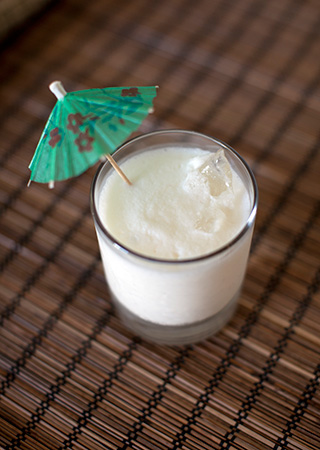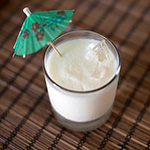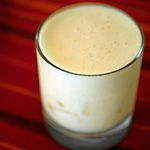If you spend anytime on a beach in Brazil, you will undoubtedly come in contact with one of the country’s archetypal cocktails: the batida.
Like the algarobbina to the Pisco Sour in Peru, the batida (pronounced ba-chi-da) is Brazil’s other cocktail to the iconic caipirinha. The sweet, refreshing drink is one of the best ways to cool down your body under the blazing Atlantic sun, while giving a little extra oomph to your tudo bom vibe. It’s sort of like an alcoholic smoothie. The name comes from the Portuguese term batida, which generally refers to any shaken or blended drink, but in Brazil is usually more specific, referring to a blended drink with cachaça.
The secret to the drink is the use if leite condensado, or sweetened condensed milk, which is a signature ingredient in dozens of Brazilian sweets, ranging from brigadeiros (soft, chocolate sweets) to pudim de leite (milk pudding). Rather simple to make, most batidas follow a standard recipe: cachaça (Brazil’s sugarcane liquor) + fresh fruit/fruit juice + sweetened condensed milk + ice. Everything is blended in a blender and served in a small glass; usually adding additional crushed ice before serving. Batidas may also be shaken, which should be done rather vigorously in order to allow enough air to enter the drink so it becomes thick and frothy.
You’ll rarely find batidas at a hotel bar or restaurant, rather they’re most often sold from a barraca (ba-ha-ka), a sort of mobile bar or small restaurant on or near the beach, like on Rio’s boardwalk, that sells things like bottles of water and iced coconuts and rents beach chairs for a patch of sand. Yet these small stands are able to make batidas from scratch, usually utilizing whatever fresh fruit they have handy, which in Brazil can change drastically wherever you are. The most common batidas are made with maracujá (passion fruit), cajú (cashew juice), or agua de coco (coconut milk), though even more exotic flavors such as açaí, graviola (soursop), or acerola can sometimes be found. Occasionally they’ll have ridiculous names like angel piss or virgin sweat. In the Bahian state of Salvador during Carnival, apple is used to make the party drink of choice, Batida de Maça.
The following recipes are ideal for a hot summer day or warm night. If cachaça is unavailable you can replace it, with vodka.
Batida de Coco (Coconut Batida)
- 2 ounces cachaça
- 3 ounces coconut milk
- 2 teaspoons simple sugar
- 1 ounces sweetened condensed milk
- 1 cup of ice
Batida de Maracujá (Passionfruit Batida)
- 2 ounces passionfruit puree
- 2 teaspoon simple sugar (leave out if using passionfruit juice instead of puree)
- 2 ounces cachaça
- 1/4 can of sweetened condensed milk




![Making Mealtime Matter with La Familia: Easy Sofrito [Video]](https://thelatinkitchen.com/wp-content/uploads/2015/10/sofrito-shutterstock__0-500x383.jpg)
![Easy Latin Smoothies: Goji Berry Smoothie [Video]](https://thelatinkitchen.com/wp-content/uploads/2015/12/goji_berry-shutterstock_-500x383.jpg)
















![Fun and Fast Recipes: Fiesta Cabbage Salad [Video]](https://thelatinkitchen.com/wp-content/uploads/2015/11/fiesta_cabbage_slaw-shutterstock_-500x383.jpg)









